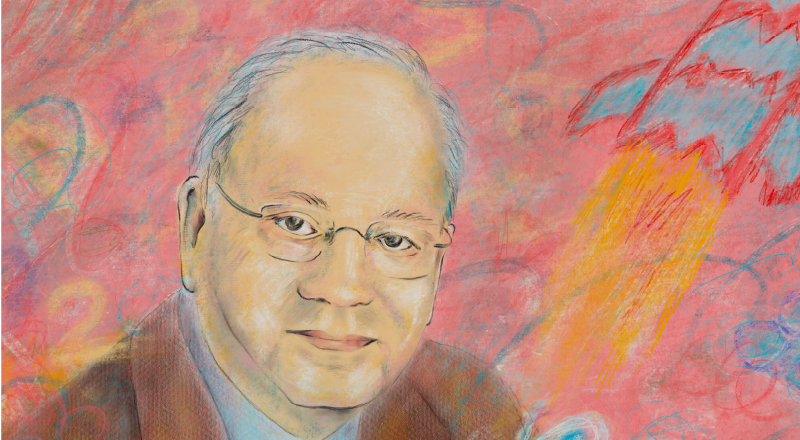I sat down in the grass and found myself, at 45 years old, in the backyard alone, sobbing uncontrollably.
I planted a rose bush in my garden that spring, the second of the pandemic, the one where I finally came to my breaking point. I chose the sunniest spot in my whole yard, right against a wall near the walk. Gardening had always brought me peace, but as I dug the ground and set the little bush in its place, I felt a sigh welling up from deep within. I sat down in the grass and found myself, at 45 years old, in the backyard alone, sobbing uncontrollably.
Five years earlier, I had joyfully started a new position opening a new high school. It was difficult work, but one of the proudest chapters of my 21-year career. We had early and late meetings with a full day of teaching in between, while inventing everything and piloting assessment and pedagogical models. At the same time, I was earning my master’s degree. Outside of school, I was devoted to supporting my own three teenagers as a single dad. I volunteered in the community, drove to marching band, dance and basketball as we navigated part-time jobs and their transition from high school to university. When friends said “you shouldn’t be sad,” I ignored the warning signs and used busyness to push down my feelings.
Compassion fatigue was how I first noticed myself deteriorating inside. It became difficult to regulate my emotions while working with students. I would escalate very quickly and lost my characteristic sense of humour. My room had always been open for kids outside class time, but I started closing my door. I turned out the lights and closed my eyes in the middle of the day. I became hypersensitive to noise, and student banter grated on my nerves.
Externally, I kept up appearances. I coached cross-country running, led professional development, looked after guest teachers, guided my department through changes in assessment paradigms and remained a sounding board for colleagues. I did everything I believed was expected of lead teachers.
My assistant principal began to notice changes. She came for chats more frequently and I began to divulge that I wasn’t happy. With her encouragement, I got in touch with Homewood Health and began to see a psychologist. He was wonderful. Gradually he revealed to me that I was experiencing burnout and the condition’s impact on individuals and relationships.
Burnout explained all of my symptoms, including headaches, poor sleep, fatigue, concentration issues, feelings of worthlessness, loss of interest in the things I once enjoyed, and emotional vulnerability, such as what I experienced while sobbing on the lawn. I realized that the depression that had plagued me for years and the need to put on a charade just to get through the day were all symptoms of this bigger issue.
I started along a journey to healing. I needed first to change my work environment. I moved schools and welcomed a different set of leadership challenges. The hardest part of dealing with a crisis of mental health was that it was so isolating, and I felt like the only one who wasn’t able to cope, so I made efforts to say yes when friends asked to do things instead of finding excuses and slowly began to tell them what was happening with me.
My best friend, who is a nutritionist and trainer, suggested changing my diet, which made a tremendous difference. She became my closest confidant and was able to let me be honest about my feelings. She helped me to see the links between physical and mental fitness. She also didn’t let me waste time on self-pity, which was refreshing and necessary. She encouraged me to travel and write and read and helped me find the pieces of myself that I had slowly lost as my candle burned at both ends. I rediscovered running and cycling, which I had formerly enjoyed but let slide. I lost weight and began to feel like myself again for the first time in a long while.
Recovery from burnout takes daily work. Journaling is part of my morning and evening routine; it helps me immensely to notice what is happening inside and to remind me to tell others what I am experiencing so I’m not struggling alone. Devoting time to healing allowed me to rediscover my passion for teaching, give my true self to my students and re-embrace their energy. There are still hard days, especially during winter. But I am back at peace in my garden, a little further along the path, and this past summer my rose bush was covered with blooms.
Teachers face incredible pressure and we want to do so much to help others to grow. I learned the importance of letting myself be helped so that I could once again give to those who need me.
Editors note
This feature contains some very frank, personal stories that teachers have written about their experiences with mental illness, including suicidal ideation, PTSD, anxiety, depression and burnout. All the contributors were willing to have their full names attached to their stories to help normalize conversations about mental health and reduce the stigma often associated with mental illness.
However, the ATA Magazine’s editorial team chose to include only contributors’ first names and their general roles. This decision came after much debate and with the understanding that no single approach is perfect.
Mental health is a sensitive topic, and those who share their journey should only be praised, but being open about mental health may expose a teacher to risks to their employment prospects or targeting on social media. For this reason, we’ve decided to preserve the privacy of these teachers.
By focusing on their experiences and insights, we hope to contribute to a more empathetic and understanding approach to mental health, both within the profession and broader society.
Learning Leader
Read more
View the entire digital issue of the ATA Magazine
See the latest issue


